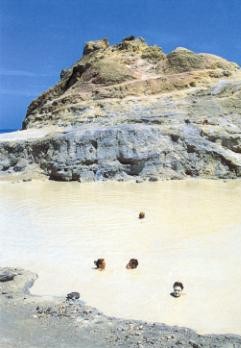 |
 |
Once Hiera Thermessa, Vulcano is one of the most fascinating islands of the Aeolian archipelago because of the variety of its volcanic phenomenon and of its amazing landscape. With its 717 inhabitants, it spreads on 21 sq km. It has a vast plateau on the south side, Mount Lentia in the west and in the north , the Vulcanello peninsula which emerged from the sea in 183 B.C. and is linked to the island by a small neck of land.
There were once three craters on the island, however, the sea has eroded one of them and all that remains today is a section of the cone with its flow of lava and the stratification of the dejection materials.
Smaller secondary craters (mount Avia, Luccia, Saracena) as well as the plain of Vulcano Piano can be observed at the south of the island.
In the center of the island, the crater of Vulcano Fossa has two cones from the historical eruptions which were explosions followed by flows of lava. Just like the ones of Pietre Cotte on the northwest side, which took place at the end of the XVII century. The volcano has been known to erupt since the antiquity: Thucydide in the V century B.C. was the first one to describe it. There have been fifteen known eruptions since. The last one, with explosion and expulsion of material called bread crust bombs, goes back to 1888-1890.
 |
Since then, the volcanic activity has limited itself to fumaroles with regular gas emissions. The natural pool of sulfuric mud has great therapeutic virtues; it is considered to be very effective for joint and nasal problems, for phlebitis, ulcerated varicose, for problems relating to the female genitalia and other dermatological troubles.
The islandís big prerogative is the west beach close to the rocky cliff. With its very hot water due to the continuous emission of underwater fumaroles, it is similar to small fountains in the middle of the sea. The thermal virtues of these waters are what forged the islandís reputation and insure a constant influx of tourists throughout the year.
The caves of the Allume and the Rosi, whose splendor is suggestive, not visible from the sea are definitely worth a visit. Also, a boat tour around the island will enable you to admire the Horse cave and to stop at the other welcoming and delightful Gelso beach which is characterized with its extremely fine and very black sand (volcanic ashes). The crystal clear water of the sea will also surely astonish you.
 |







